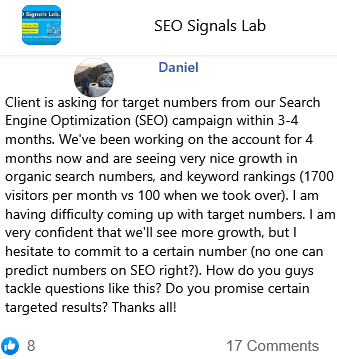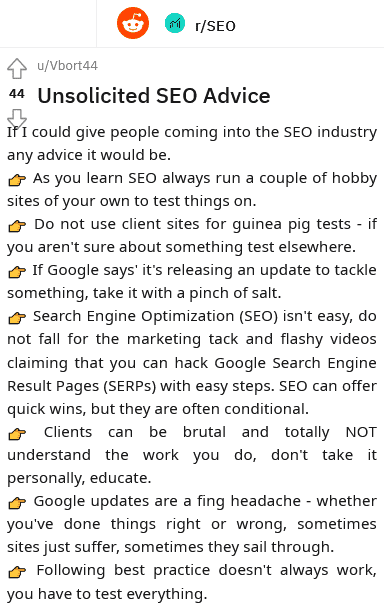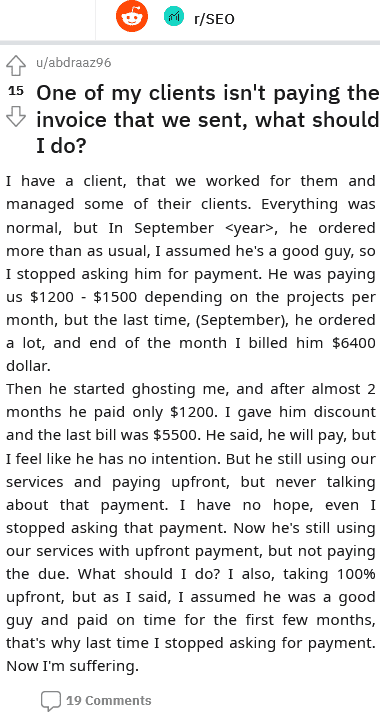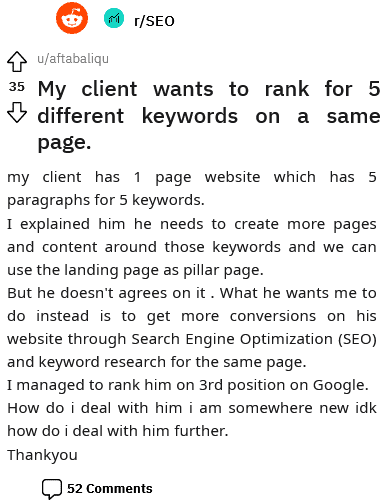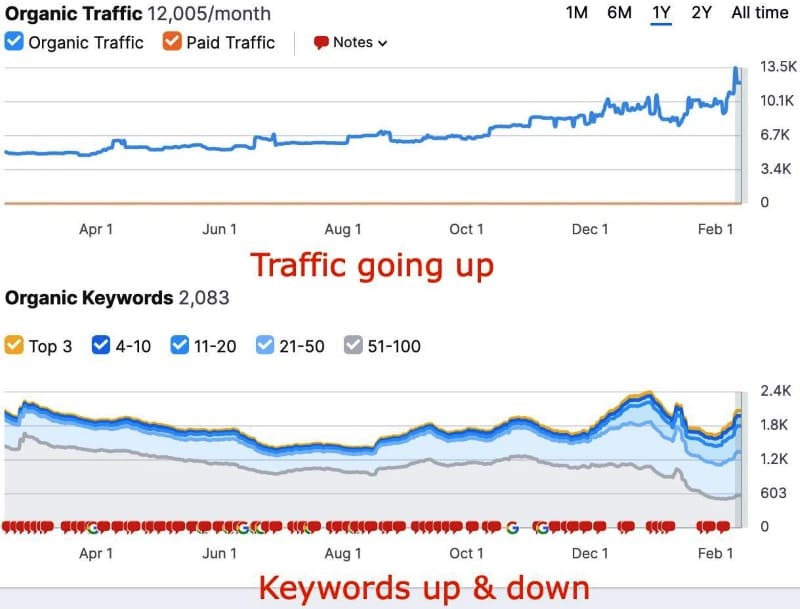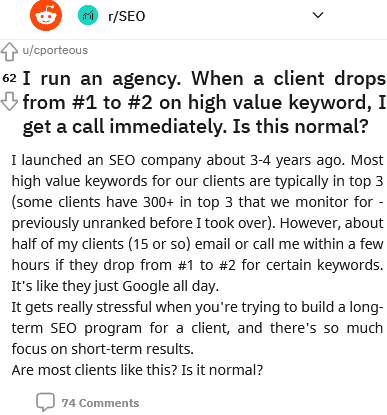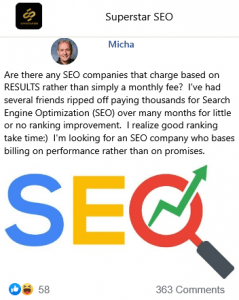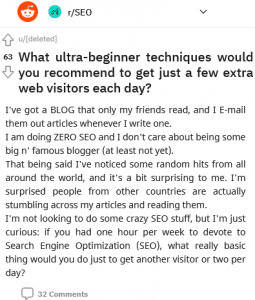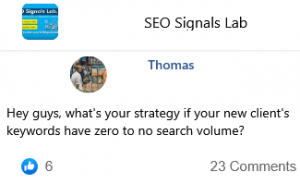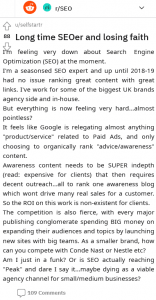Client is asking for target numbers from our Search Engine Optimization (SEO) campaign within 3-4 months. We've been working on the account for 4 months now and are seeing very nice growth in organic search numbers, and keyword rankings (1700 visitors per month vs 100 when we took over). I am having difficulty coming up with target numbers. I am very confident that we'll see more growth, but I hesitate to commit to a certain number (no one can predict numbers on SEO right?). How do you guys tackle questions like this? Do you promise certain targeted results? Thanks all!
8 👍🏽817 💬🗨
📰👈
I tend to frame things like that like "With what we're seeing so far, we can hope to see X, and we can almost certainly expect to see Y. Our intent is to try very hard to reach Z, though."
X is a mid range number – probably something that looks at the growth curve so far, carries that out for a period of time, and then puts a reasonable number on it. This is not a guarantee – but the trend so far is saying that this is something not unlikely to be attainable.
Y is a safe number. It may not signify resounding success, but it still justifies your existence. The client may not be ecstatic with merely hitting Y, but they won't be ready to toss you in the can, either. Y should be a number that you're pretty darn certain you can hit without any problem – and if Y is not big enough to justify your existence (at least if you've been at this for 6 months or so) then it might be time to assess yourself and consider if you can actually handle the job.
Side Story: We had to hand off three clients this year. The agency I do most of my work for is only 6 people. As such, when a company hits a certain point and needs to see a certain level of growth to continue pace, there eventually comes a time when we simply cannot adequately handle it for them. So, we fess up to that, help them find and screen a larger agency, work with that agency for a month or so to get them up to speed with our existing strategy and make sure things are set to transition properly and everyone has what they need to make the upgrade almost invisible – to the client and to Google.
There is no shame in knowing and admitting to your limits. Two of the three agencies we handed our clients off to this year have referred companies to us that were too small for them to bother with, but that we can nurture and grow for 3-4 years and then hand back to them, ready to burst out huge.
Z is the ambitious number. It's that number that is realistically possible, and something worth striving for – but it's also a number that is going to take a lot of work, no mishaps, a few experiments paying off that might not pay off as expected, and no major surprises – like COVID shutting down the supply line so the client can't deliver on anything we're trying to send their way. It's a number that we can hit probably 1/3 of the time – but it's a great number to always be shooting for because it makes the lower numbers that much easier to achieve.
The one thing I see missing from your question, though… is quality. You're talking all quantity. 1700 visitors from 100 is great – if those 1700 are people who can be converted to a sale. It's at this point in the process where (assuming you're solely the Search Engine Optimization | SEO team and not a full digital marketing team) you need to start looking at what's happening with all this traffic.
What percentage of these are converting?
How easy are they to convert?
Are they landing in the right place to most easily convert them?
Frankly, slowing raw number growth in favor of increasing quality and convertibility of the traffic you're generating is not only critically important, but also takes the burden off the growth efforts. 5 people per day who want your stuff is far better than 100 who don't.
At this point, it's time to work with marketing, sales, and Conversion Rate Optimization | CRO teams if they have them, offer to serve those needs if they don't (and they are things you can provide), or encourage them to bring on people who can do that. (It's actually never to early to do this… but at 170% growth, it's gotten to the point where it's imperative that you do that).
The numbers become a lot easier here, too. Because now you're not just saying, "I'm bringing you A more people, give me B more dollars." you're saying, "I bringing you C more dollars, so give me B – a small percentage of that."
🤔10
Thank you so much for your insights and patience. Very good feedback. And you are absolutely right that we have not really looked at CRO here (the budget simply does not permit it, and the client has someone else "taking care of" the website). But i will implement your goal setting strategy. Thanks again.
Truslow 🎓
re: "The budget does not permit it."
I'll be a bit frank here – the budget MUST permit it at some point.
You've gone from 100 to 1,700 per month. Now… if you take that and turn it into 17,000 per month – what have you given them? What's the value? Who knows?
With CRO and SEO working together, I can (if planned properly) take a big chunk of the budget that was aimed at hitting that 17k number and put it toward CRO. When I do that – then I can have a target of 3.4k maybe, and generate MORE revenue for the client than they would get with the 17k and no Conversion Rate Optimization (CRO)
Think about that for a minute. For the amount of work it takes to double current traffic, you can accomplish the same thing (or better) as it would take you to increase the traffic ten-fold. And now you've still got some room to continue to increase traffic even more.
HINT: There's a point of diminishing returns in play here – you pluck the low hanging fruit early, so as more and more traffic comes, it actually takes more and more traffic to provide the same value. In other words – those first 10 visitors have X value – the next 10 have slightly less value – and the last 10 (at some point) end up having very little or no value.
If you aren't maximizing the value of what you already have – there's waste involved. The more waste in a system, the less effective it is.
This means that if you are only focusing on traffic goals, every bit of new traffic you attain has less value – which in turn makes YOU less valuable. And, of course, as your value goes down, it becomes that much harder to convince them to continue with your services once it comes time to re-up your contract.
John Wooden, famous UCLA basketball coach, said: "If you don't have the time to do it right, when will you have the time to do it again?"
Daniel ✍️ » Truslow
Pure gold. I am going to have CRO conversation with the client here asap. Thanks again!
Igor
I make it pretty simple. You will see increases month over month. If they are not up to your liking you can fire us at any time. Just focus on delivering results and get clients that will not BS you in regards to vague metrics.
📰👈
Petter
Stockbridge said it, but how to solve it:
Based on current pace and planned activities as well as experience about planned activities and knowledge about current ranking and search volume. Apply this to build a model (excel/spreadsheet formulas can get you there) that caps out at max potential (#1 across all target keywords) with 3 outcomes:
– Continue growing at today space
– Increase the pace by 10% faster growth
– Increase the pace by 20% faster growth
You can also apply python for this once you have sufficient datapoints.
Thanks for this!
Ammon 🎓
I'm primarily a fan of always designing the reporting around the specific objectives. Also, the closer to bottom-line, direct business driving figures the better.
I stopped doing 'Ranking Reports' for anything but a few 'representative phrases' some years back simply because there is no single fixed conversion or correlation to rankings across anything. What I mean is that even for a single client, a single site, a single product, you can have one ranking that is amazing and drives barely any conversions, and another where ranking is mid page or even bottom half and drives 8 times the business of many of your top ranking phrases. Rankings are a noisy signal with no fixed translation to anything that actually means business improved.
Likewise, traffic is fine to report where a campaign is about boosting brand awareness, where just being seen is part of the bottom-line objectives, but outside of that it is useless *except* in combination with the conversion rate. We all know how easy it is to boost traffic by being less selective, and drawing in people who will visit but never convert. There are more than a few campaigns where we boosted profit considerably by *reducing* traffic, to be far more selective about pre-qualified, business-intentional, visitors.
Remember, every single visitor that didn't convert *might* be a visitor who was unimpressed, and is now telling everyone they know how unimpressive your business was. So keeping an eye on the conversion rates, the bounce rates, and attempting to gain more data about what the non-converts are doing afterward is always important to the long-term health of the site and business. Do everything you can to eliminate visits that will carry away a negative experience, that felt you overpromised and under-delivered, or otherwise didn't offer what the hype of your marketing said you would. Focus on bringing customers, and business, not just 'visits'.
So, with all that in mind, I'm trying to do business projections right from the get-go. I won't even take a client on if I am not certain I can drive (over the course of 6 months) at least 5 times more bottom-line PROFIT than the fees and costs of my proposal. Or in other words, I'm predicting bottom line profit minimums before I even take the client, or make a firm proposal to the client.
It isn't all about growth in traffic. If a site is already fairly well established, and has decent traffic, you'll usually find that it is a LOT easier to get 50% more profit from converting more of the traffic they have (in a lot of sectors that is simply going from a 2% conversion rate to a 3% conversion rate) than to attract 50% more people without any of those extra people being less qualified, less eager, less ready to buy. Some of it may be based on lowering their Pay Per Click (PPC) costs by removing some of their paid positions replaced with high organic ones. Or indeed, switching some of their offline marketing budget into more efficient and effective online marketing. Heck, even helping them eliminate recruiters (who charge 15% of the first years salary for each position they fill) by advertising their own jobs, or getting people to apply even before there is a vacancy counts. Or reducing their spend on Customer Support by having more effective online FAQs, etc.
When I've explained this in the past, over the many years, I always get a few people asking "How do you get clients to give you the business data to make those kinds of proposals?". The answer is I ask for them. It really is that simple. I need them to make these kinds of decisions, so I ask for them up front, without a second thought. Most clients never blink, never mind question it, because they too know why I want those figures, and why I need them to make the kind of proposal they want to get – hard profit numbers.
That said, as Truslow says, these have to be clearly stated as predictions, forecasts, based on the data available. I make sure the client knows that if a sudden huge market-shift, or a huge algorithm update, come along, it may affect the figures, and that we'll deal with such things as and when they arise. The good news is I've never really needed to call on that. If you are smart, *most* big shifts give warning signs. It's only something like Covid if you had a client in the travel or hospitality sector suddenly shut down by lockdowns that these matter – and it's not like a client in that state is unaware of what is happening.
Ultimately, my advice is to get as close as you can to bottom-line, actual *business* metrics, and away from the amateurish 'visits and rankings' unless you can make guarantees on exactly how visits and rankings convert to profit.
I agree with everything you're saying. I guess you must always take over the client's website in that case? And you start with a website redesign or refresh in order to improve conversions (therefore you increase your requested budget)? I am asking because i imagine you can't really improve conversion without redoing at least part of the website.
Ammon 🎓 » Daniel
Actually, I'm usually a consultant, and as 'hands off' as can be, advising and guiding their own team(s). Anything one can change, one can instruct someone else to change.
Nathan
Personally, before I begin work we already have turned in a roadmap to success. Meaning they know what to expect, what stage we will hit X, what comes next, and so on. This question doesn't arise as we went over it all from day one.
You can't predict what is coming or what will happen but based on experience and auditing their site I am able to set benchmarks and predictions which are pretty accurate.
Can you share the roadmap template you are using?
A.J. Jagodic
send monthly reports showing them organic growth…if it still not enough…"offer" them 1000 chinese spam links if they want to disappear forever…but they will have immediate results 😂
Lol we already provide detailed monthly reports, and the numbers are fabulous tbh. Just the client wants more of a Key Performance Indicator (KPI)-driven approach, and honestly i don't blame them. Just it's been difficult to provide something like that…
A.J. Jagodic
in that case u can't win…what u can do is recheck their onsite and try additional keywords and opportunities…but other than that advise them to use Google Ads…if money is not an issue and if they need immediate results right away
📰👈
How to Determine Which Client Should get Marked as a Red Flag in SEO and Marketing?
A PPC Client is now Refusing to Pay the Next Invoice Claiming that We’ve only done
Tips to Land High-Paying Clients in Digital Marketing on SEO Projects
Paying a Content Writer as Percentage Instead of a Fixed Price
